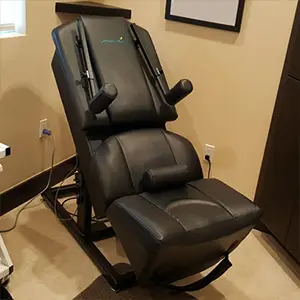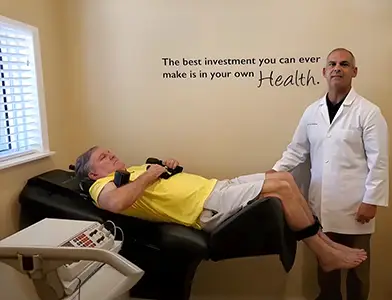Revolutionary Relief for Chronic Back on Track Decompression
Back on Track Decompression reduces the painful spinal disc protrusions, bulges, and herniations. This traction also decreases spinal degeneration stenosis pain and numbness. The specialized traction treatment causes intra-discal pressure to drop from a positive to a negative pressure. This negative pressure promotes the diffusion, or intake, of water, oxygen, and nutrients into the damaged dehydrated disc, thereby rehydrating the degenerated disc.
Pressure relief brings blood and other nutrients to the damaged part of spine where it also begins healing. Spinal compression’s development MEANS your fate could be due sooner rather than later-to become a peripheral neuropathy sufferer.

Back on Track Decompression is an advanced method for bringing relief to back pain and spinal problems. It does so through gentle stretching and vibration that relaxes the body as well as provides immediate help without uncomfortable straps or a stiff back from long clinic stays and long drives.
In addition to focusing on the major Lodestar of the spine-line, the neck and hips and lower back are also treated. The results have been proven effective: both doctors as seen from their reviews and patients alike all report improved management for back pain as well as general wellbeings.
Understanding Back on Track Decompression
Cutting-edge treatment-Daily Comes a New Back Padding? using back on track Decompression-worthy of a try for anyone who suffers from chronic back pain or spinal problems. It incorporates gentle Stretching and Vibration to focus on the key areas of body: By providing immediate relief, this effective new technology affords lifestyle benefits that last.
The Science Behind Back on Track Decompression
At the heart of Back on Track Decompression is a profound grasp of spine biomechanics and how gentle stretching and vibration can positively affect spinal health. Through scientific research and clinical tests, the effectiveness of this treatment is well documented.
How Back on Track Decompression Works
Back on Track decompression unloads the spine by gently stretching dimensions in which it gets compressed, tilting vertebrae off of one another. Neck and hip muscles are also stretched because gently soothing the back places long-term therapy process into all parts of the body. In addition, the vibration adds to therapeutic effects. It functions to relax and promote blood circulation throughout the entire body.
The Role of Gentle Stretching in Therapy
Lower Intension and Spasm of the Muscle. Reduction in overall pain felt as muscles relax. Mcreasing flexibility Allows one to stand up straight, making a big improvement in sense of wellbeing.
The Importance of Vibration in Treatment
Vibration is an integral part of the Back on Track Decompression treatment. The vibrations which help to stimulate circulation and relax muscles make it easily the best overall therapy. These soothing contemporary treatments include a session where one feels soothed by those gentle shudders.

Benefits of Back on Track Decompression
Immediate Relief and Long-term Benefits
With Back on Track Decompression immediate relief from back pain and muscle tension. Plus the long-term benefits include improved mobility and overall well-being.
Back on Track Decompression targets key areas of the body to provide comprehensive pain relief and relaxation.
Areas of the Body Targeted
- Spine and Neck
- Hips and Muscles
- Lower Back or Sacral
Common Conditions Treated with Back on Track Decompression
Chronic Back Pain
Chronic back pain is a debilitating condition that affects many individuals, causing them discomfort and limiting their mobility in daily activities. For patients suffering from persistent back pain, Back on Track Decompression offers a non-invasive and effective solution to this problem.
Degenerative Disc Disease
A common spinal disorder, degenerative disc disease can lead to pain, stiffness or limitation on the flexibility of one’s movements. Back on Track Decompression uses gentle stretching and vibration to target affected areas for patients who are accounting with this ailment–hence easing symptoms and improving overall spinal health.
Other Spinal Issues
- Sciatica: Back on Track Decompression can provide relief from the shooting pain and numbness caused by sciatica, promoting better nerve function and mobility.
- Scoliosis: For individuals with scoliosis, Back on Track Decompression offers a gentle yet effective approach to addressing the spinal curvature and associated discomfort.
- Herniated Discs: By decompressing the spine and reducing pressure on the affected discs, Back on Track Decompression can help alleviate pain and promote healing.
Patient Experience and Feedback
Stages of the Treatment Session
In the context of each patient’s individual needs, a structured therapeutic session is arranged at Back on Track Decompression, involving:
- Initial Setup and Positioning
- Experience During the Session
- Post-Treatment Feelings
Improving patient care
If Back on Track Decompression were to be incorporated into a medical setting, then this would provide a comprehensive means of treating chronic back pain and spinal conditions..
Comprehensive Care Integration
- Addressing a variety of spinal-related problems
- Improving patient outcomes
- Enhancing the overall patient experience
Improving Patient Quality of Life
- Decreases pain
- Renders greater freedom of movement
- Improves temperament as well as physiology
Frequently Asked Questions (FAQs): Back on Track Decompression
What is Back on Track Decompression therapy?
Back on Track Decompression therapy is a non-surgical, drug-free treatment that uses a specialized traction table to gently stretch the spine and relieve pressure on the spinal discs and nerves. This therapy is designed to alleviate pain and promote healing in conditions such as herniated discs, sciatica, and degenerative disc disease.
How does Back on Track Decompression work?
The therapy involves lying on a decompression table where gentle, computer-controlled stretching forces are applied to the spine. This creates negative pressure within the spinal discs, helping to retract bulging or herniated discs and improve the flow of nutrients and oxygen to the affected areas.
What conditions can Back on Track Decompression treat?
Back on Track Decompression is effective for treating various spinal conditions, including:
- Herniated or bulging discs
- Sciatica
- Degenerative disc disease
- Spinal stenosis
- Facet syndrome
- Chronic lower back pain
Is Back on Track Decompression therapy safe?
Yes, Back on Track Decompression therapy is considered safe for most patients. It is a non-invasive treatment with minimal risk of side effects. However, it is important to have a thorough evaluation by a healthcare professional to determine if this therapy is appropriate for your condition.
How long does a Back on Track Decompression session last?
A typical decompression session lasts between 30 to 45 minutes. The exact duration may vary depending on the individual’s condition and the treatment plan prescribed by the healthcare provider.
Who should avoid Back on Track Decompression therapy?
Decompression therapy may not be suitable for individuals with certain medical conditions, such as advanced osteoporosis, spinal fractures, tumors, or infections. Pregnant women should also avoid this therapy. Always consult with a healthcare professional before starting decompression therapy.
How do I prepare for a Back on Track Decompression session?
No special preparation is needed for a decompression session. It is recommended to wear comfortable clothing and avoid heavy meals before the session. Your healthcare provider will give you specific instructions based on your treatment plan.